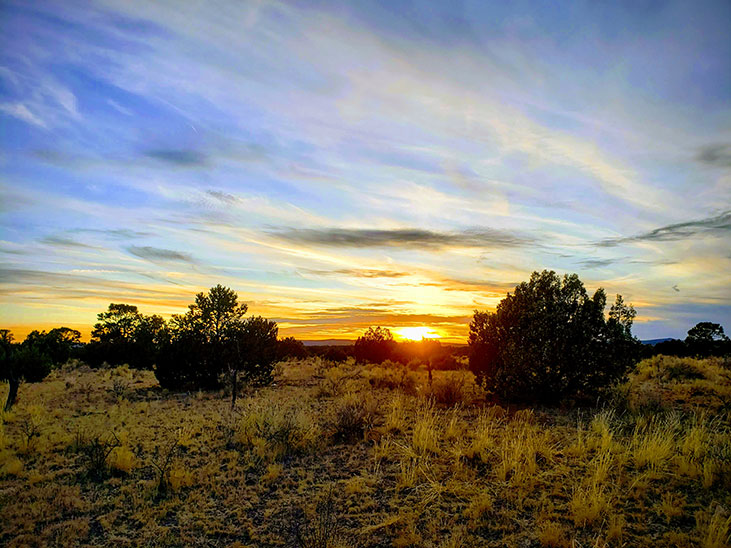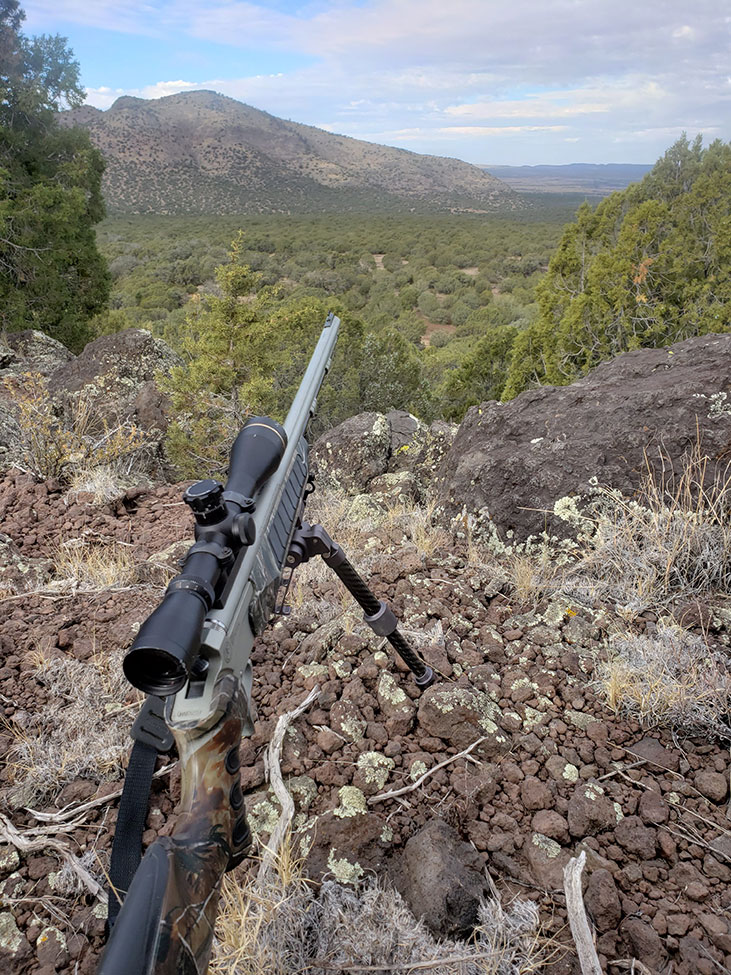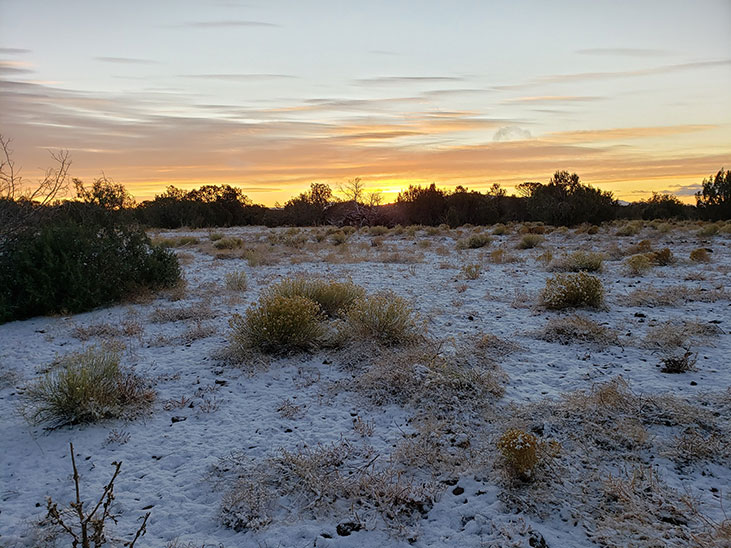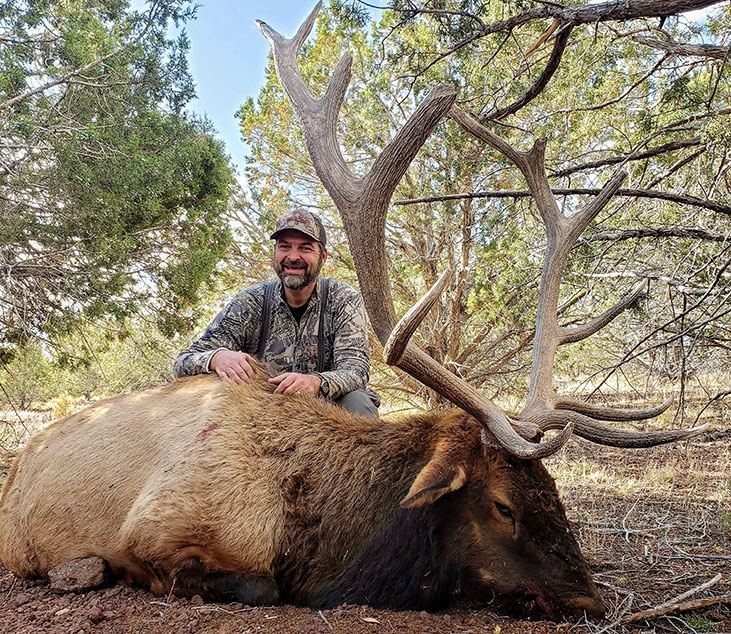Red – An Arizona Bull Elk Story
Sometimes in life you just need a mantra. Ten simple words, playing like a mental marching band, had become mine. “Climb the hill, set up the gun, locate the bull.”
On opening morning guide Carson Lengvary and I were camped on the Big Boquillas Ranch — The Big Bo — in Arizona’s Game Management Unit 10. The Big Bo is a special place that provides an incredible opportunity for wildlife.

Officially Arizona’s largest working cattle ranch, the Big Bo has 750,000 acres of high-altitude grasslands and mountains banded with juniper and ponderosa forests. Importantly, the Big Bo maintains hundreds of water troughs and dirt tanks that serve both cattle and wildlife. With all of Arizona in a severe drought, we were counting on the ranch’s water resources to help locate good elk numbers.
Arizona’s Unit 10 is managed as a trophy elk unit, so residents can expect to wait five or more years to draw a bull elk tag here. Despite freakish odds, this was the third consecutive year I had drawn the muzzleloader tag in GMU 10.
Last year, Carson and I had gone the distance with these elk, and frankly we got our butts kicked. We had been close on several huge bulls, but we walked away tag unfilled. So, after last year’s whooping, we were looking for redemption.
Long before first light, we climbed into the Jeep for a dusty 45-minute scramble to an area we had only speed-scouted the day before. We hadn’t had time to glass the area, but the topography was ideal, and there was a good water tank nearby.
Pumped full of caffeine and confidence, we raced to get to our spot early. We were tearing over washboard and ruts when we were surprised by headlights already ahead of us. We passed several trucks in a half-mile span, all happily parked well short of our target spot.
About two miles deeper, at the end of the trail, we parked and quietly slipped on our packs. Thankfully, we were all alone as we climbed with headlamps for about 15 minutes up to our glassing knob. After gaining the ridge, we spread out and set up in a pile of jagged volcanic boulders to wait for glassing light to arrive.
It was a crisp 24 degrees, mostly overcast, with a cold and gusty 30-mph wind blowing in our faces from the east. A snowstorm was due to roll in sometime after lunch, and we were expecting several inches by nightfall.
Our glassing knob was a bald volcanic cone nestled within a larger bowl about a mile across. Several side canyons and draws provided shelter from the wind and created secluded pockets, perfect for a bull to hide in. The hillsides encircling us were dotted with just the right amount of juniper so we could glass the whole area from our vantage.
Before sunrise, Carson spotted three small broken bulls across the canyon to our east. We watched the young bulls move up and out of the side canyon before we decided to relocate out of the wind. With a better vantage looking south, and warmer out of the wind, it was only a few minutes before I spotted our bull.

At first, I could only see the tips of white antlers weaving through the olive juniper canopy. When he finally stepped into a clearing, we saw a huge frame and at least six points on each side, maybe seven. With the sun just creeping over the horizon, we were shocked to watch as the bull just bedded down, tucked out of the wind, about a mile away. He was in a great spot to stalk, and we could see a good bluff that would be in range for the muzzleloader. We rushed to grab our packs and put the plan together.
Excitedly, we went over the plan twice before we set off. We were going to sneak off the glassing knob down to the east, then move south across the middle of the bowl. Our final approach to the west would put us within range and slightly above the bedded bull. We just needed him to stay bedded long enough for us to make a move and get set up.
Spoken in a calm and steady voice, Carson said: “All I want you to do is focus on three things: climb the hill, set up the gun, locate the bull.”
It was half-way into our stalk before Carson’s words started to sink in. Every time we stopped to catch our breath, Carson would turn to whisper: “Climb the hill, set up the gun, locate the bull.”
Our hike was pretty straightforward, with a little side-hilling and a few juniper snags thrown in to keep it interesting. Nearing our final approach, we stopped briefly to check the wind and plan our next steps carefully.
Climbing the last ridge as quietly as we could, we hoped the bull was still bedded right where we’d left him. Cresting the ridge, we dropped our packs and slipped into a small opening under the junipers. We emerged from the tree line to find ourselves right on the edge of the bluff that we had targeted from our glassing knob.
Carson started glassing to relocate the bull, while I quickly groomed a shooting position free of rocks and sticks on the edge of the bluff.
Using a triangle of landmarks, we knew roughly where he had bedded down, but we could not see the bull immediately. After ranging the area, we decided to be ready for a shot at around 200 yards.
We had a few small shooting lanes, but it was tight and there would be no second chances. All set up and ready to shoot, we settled in, looking for any sign of the bull to get up and move beds. We were prepared to wait him out all day if necessary. I managed to relax and actually started taking a few pictures, when the bull stepped out.
Carson immediately spat out: “That’s him! Shoot him quick!”
The bull had suddenly appeared out of the trees, standing broadside in a shooting lane 190 yards away. I dropped onto the muzzleloader and crawled a few feet forward before getting a good sight picture.
The bull was walking slowly and already was half-way across the narrow shooting lane. I never felt my thumb cock the hammer back, but I was holding on his front shoulder when the trigger break came as a complete surprise.
Through a cloud of acrid smoke, I saw the bull hit the ground like we had dropped a piano on him. Time seemed frozen as we both watched the bull on the ground. Seconds later we snapped out of our trance as the bull began struggling to stand. Carson barked, “Reload and hit him again.”
Hands shaking and facing away from the now-standing bull, I rushed through my loading procedure. I had almost finished when Carson said: “Better hurry. We’re about to lose him.”
Wheeling around, I could only watch as the wounded bull slipped into the trees, with no shot. We sprang to our feet and sprinted 20 yards to our left to quickly set up at a different angle, ready for the bull to step out again. Then we waited for what felt like an eternity.

We heard no crashes in the trees. There were no sounds of movement at all, just absolute silence. Ten minutes passed. With no sight or sound from the bull, we felt pretty confident the bull was down, just out of sight. To be sure, we waited five more minutes and then we started to quietly creep down the ridge. We looked for the dead bull under every tree.
Carson spotted him first. Through a window in the junipers, we could see him still on his feet, facing us just 50 yards away. We were so close that all I could see in the scope was the bull’s head covering his vitals.
Seconds crept by before the bull finally turned his head to expose his chest. Slapping the trigger, I watched the round hit home hard, dead center. The bull leaned heavy to one side, and then back to the other, tipping over with a hollow thud as he hit the ground. Carson ordered: “Reload!”
With the gun hastily reloaded, I returned my focus to the now downed bull. It was clear he was not getting back up and so we just sat there in the dirt, stunned in the silence. Then with his last breath, the bull let out a short and muted bugle before going quiet and still. His voice was haunting, yet strangely beautiful at the same time. His tone may have been weak, but his last bugle will always echo clearly in my mind. It still gives me goosebumps.
Fully absorbed in a very surreal moment, we were shocked to hear clear sounds of movement coming up the trail just behind us. Here in the middle of the never-never, we were approached by two other hunters. After a quick greeting, we discovered they were a guide with his client in tow.
They had spotted the same bull from farther away, and we had just beaten them to the shot. After hiking in and hearing our shots, they decided to come over to see the bull on the ground. They happily walked up with us to lay hands on the bull for the first time.
Kneeling beside the bull with my hand on his neck, I quietly said a prayer of thanks. After regaining my composure, I opened my eyes to really look the bull over for the first time. He was huge, even bigger than we thought. He was crowned with a wide massive frame and long main beams.
He was broken pretty much everywhere with 6 points on the left and 7 on the right. A broken first point on the right looked like a snapped baseball bat. His mass was beyond impressive in both his antlers and his body. He had scars on his face from battles. It took all four of us just to roll him up out of the dirt for pictures.
After all the handshakes and pictures were done, Carson put on a clinic. He broke down the bull like a surgeon. We found the first shot had hit dead center of shoulder, and we recovered that round in the hide of the opposite side.
After a few hours of work, we had five heavy bags of very clean meat cooling in the shade. With everything broken down and bagged up, it was time to finish the recovery before the weather started to turn.
Thankfully, on the Big Boquillas Ranch hunters can drive off established roads to recover downed elk, as long as the ground is dry. The walk to the Jeep was only 15 minutes, and soon I was squeezing through trees and boulders, through dry creek beds and deadfall, to finally emerge right at the kill site.

It only took a few minutes to load-up the meat and trophy for the drive back through the forest, down to the ranch road and finally back to camp. The drive was filled with loud music and high fives, and my face hurt from a permanent grin.
The following morning, we caped and taped the bull to settle on rough score of around 340 inches. Our best estimate is that he would have at one time been around a 370- to 380-class bull before he was broken up.
The bull had heavily worn molars and almost non-existent ivories. On his chest and knees, he had hard scrabble callouses of hide built up from a lifetime of bedding in volcanic rock. Our best guess was that he was at least 9 years old, but he could have been as old as 12.
Luckily, Arizona Game and Fish asks hunters in some units to participate in a tooth-age study. We submitted measurements of the antlers along with two teeth from the bottom jaw for study by biologists. The results of the study aged our bull at 11 years, and in the top 5 percent of bulls in the study. Our bull was an old warrior, who in the end we decided to name Red, short for Redemption.
He was measured after 60 days and came in at 335 7/8 inches SCI. That made Red No. 66 SCI with a muzzleloader.
A good friend likes to say: “There are 10 things that have to happen to fill a tag. But I have no idea what those 10 things are.” One can easily get lost in all the details in a hurry. So, when it all starts to happen at once, and your heart starts beating out of your chest, my advice is to find a mantra to get lost in. Make it a meditation to help focus your mind and help guide you toward success. Don’t overthink or overreact to a situation because sometimes, it’s just as simple as, “Climb the hill, set up the gun, locate the bull.”–Chris Gordon

